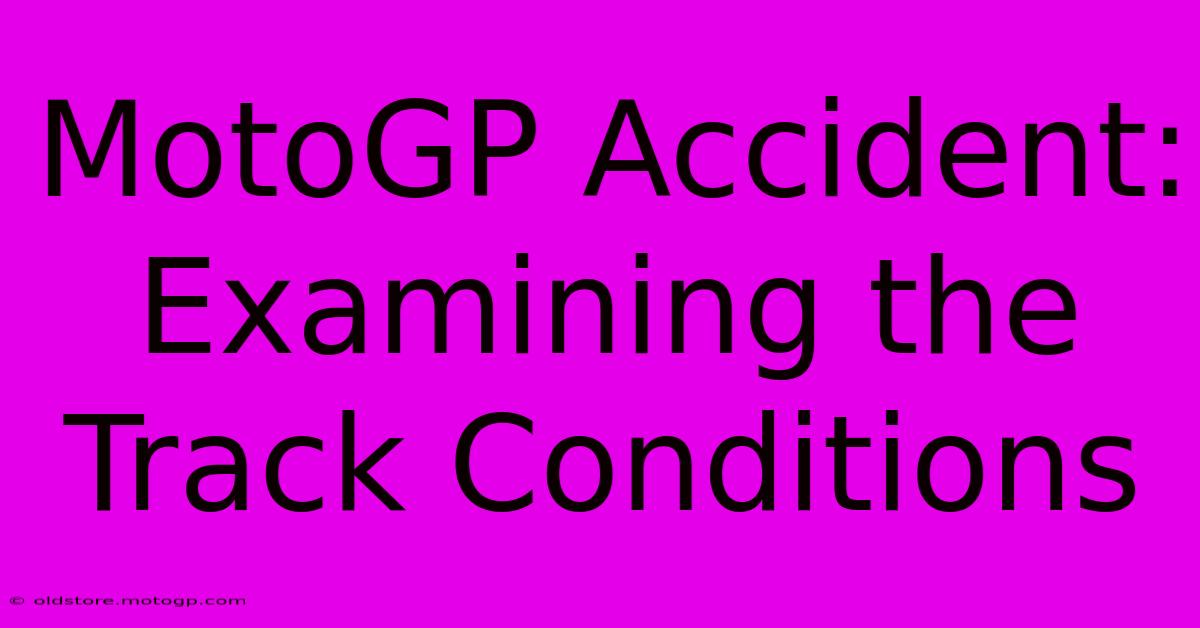MotoGP Accident: Examining The Track Conditions

Table of Contents
MotoGP Accident: Examining the Track Conditions
MotoGP racing, a spectacle of speed and precision, is unfortunately punctuated by accidents. While rider skill and machine performance play significant roles, track conditions often emerge as a crucial, and sometimes overlooked, factor contributing to crashes. This article delves into the multifaceted influence of track conditions on MotoGP accidents, exploring various elements and their impact on rider safety and race outcomes.
Understanding the Variables: Beyond Just Wet or Dry
The simplistic categorization of track conditions as merely "wet" or "dry" is far too rudimentary for the complexities of MotoGP. Numerous subtle variables significantly impact rider control and accident likelihood. Let's dissect the key factors:
1. Surface Temperature: The Silent Threat
Track surface temperature fluctuates drastically throughout the day and across different parts of the circuit. High temperatures can lead to excessive tire wear, reduced grip, and increased risk of slides, especially during braking or cornering. Conversely, low temperatures, particularly in the morning or after rain showers, can result in lower tire grip and increased likelihood of a loss of traction. This temperature variation is often a contributing factor in crashes, especially those involving cold tires.
2. Grip Levels: The Crucial Factor
Grip is the cornerstone of MotoGP racing. Optimal grip allows riders to push their machines to the limit. Factors influencing grip include:
- Tire condition: Tire wear, pressure, and type directly impact grip.
- Track surface: The type of asphalt, its age, and the presence of any debris (rubber marbles, oil, etc.) significantly affect grip levels. Older asphalt tends to offer less grip than newer surfaces.
- Weather conditions: Rain, obviously, reduces grip dramatically. However, even slight dampness or moisture can compromise traction significantly.
Low grip is the primary culprit in numerous accidents. A sudden loss of grip, whether due to a change in surface condition or tire wear, can send a rider off-course.
3. The Role of Weather: From Sun to Storm
Weather is arguably the most unpredictable and impactful factor influencing track conditions. Sudden downpours can instantly transform a dry, grippy track into a treacherous, slippery one. Even a light drizzle can significantly reduce grip, catching riders unaware and leading to accidents. Similarly, intense sunlight can increase surface temperature, affecting tire performance. Changes in wind speed and direction can also influence rider control, especially on exposed sections of the track.
4. Track Debris: The Unseen Hazard
Tire marbles, oil slicks, and other debris accumulate on the track throughout a race weekend. These seemingly innocuous elements can cause catastrophic accidents. Rubber marbles, for example, are small pieces of worn tire rubber, creating patches of low grip that can send a rider tumbling. Oil spills, often from a previous accident, create slick patches that drastically reduce traction.
Accident Analysis and Prevention
Analyzing MotoGP accidents requires a meticulous examination of all these factors. High-speed cameras, telemetry data, and post-accident investigations are crucial in identifying the causes. This information is then used to:
- Improve track design: Modifying track layouts and surfaces to improve drainage and grip.
- Develop safer tire compounds: Creating tires that better handle diverse track conditions.
- Enhance safety protocols: Implementing stricter guidelines for track maintenance and debris removal.
- Improve rider training: Equipping riders with the skills and knowledge to handle challenging track conditions.
Conclusion:
MotoGP accidents are complex events rarely attributable to a single cause. A thorough understanding of track conditions – encompassing temperature, grip levels, weather patterns, and the presence of debris – is paramount in improving rider safety and mitigating the risk of future accidents. Ongoing research, analysis, and proactive measures are vital in striving for a safer and more exhilarating racing experience.

Thank you for visiting our website wich cover about MotoGP Accident: Examining The Track Conditions. We hope the information provided has been useful to you. Feel free to contact us if you have any questions or need further assistance. See you next time and dont miss to bookmark.
Featured Posts
-
Experience The Energy Of Cota Circuit Days
Feb 24, 2025
-
Malaysia Moto Gp A Festival Of Speed
Feb 24, 2025
-
Cota Get Ready For An Unforgettable Time
Feb 24, 2025
-
Sprint Race Time The Wait Is Almost Over
Feb 24, 2025
-
Sprint Race Results Exceeding Expectations
Feb 24, 2025
